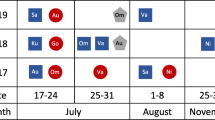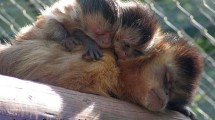Abstract
The social development of 11 free-ranging infantLemur catta was examined over the first 16 weeks of the infants' lives. By 16 weeks, infants still occasionally suckled and were carried dorsally, but on the whole, they were independent of their mothers. Sex or mother's rank was not found to affect frequency or type of play behavior. Mother's rank had no effect on frequency of maternal rejections, from the nipple or from riding, but female infants were rejected slightly more frequently than males were. Mothers tended to reject infants more severely and more frequently from dorsal riding than from the nipple. Sex and rank differences were not found with respect to behaviors determined as measures of independence; however, lower-ranking infants engaged in significantly more “dependent” behaviors than higher-ranking young did. It may be necessary for the infant of a low-ranking mother to maintain closer proximity to its mother for a longer period of time during infancy because such infants may be subject to abuse by higher-ranking group members and, furthermore, may not be as readily rescued in a stressful or dangerous situation as a higher-ranking infant. Sex was not found to be a factor in terms of measures of dependence. The lack of sex differences in developmental behaviors in this species may be related to female dominance, as well as to the fact that, as adults, both sexes engage in aggressive territorial behavirs.
Similar content being viewed by others
References
Altmann, J. (1974). Observational study of behaviour: Sampling methods.Behav. Jour. 49: 227–265.
Altmann, J. (1980).Baboon Mothers and Infants, Harvard University Press, Cambridge, Mass.
Baldwin, J. D. (1969). The ontogeny of social behaviour of squirrel monkeys (Saimiri sciureus) in a seminatural environment.Folia Primatol. 11: 35–79.
Baldwin, J. D. (1986). Behavior in infancy. Exploration and play in Mitchell, G., and Erwin, J. (eds.),Comparative Primate Biology, Vol. 2. Part A. Behavior, Conservation and Ecology, Alan R. Liss, New York, pp. 295–326.
Berman, C. M. (1984). Variation in mother-infant relationships. Traditional and nontraditional factors. In Small, M. F., (ed.),Female Primates: Studies by Women Primatologists, Alan R. Liss, New York, pp. 17–36.
Box, H. O. (1975). A social development study of young monkeys (Callithrix jaccus) within a family group.Primates 16: 419–435.
Budnitz, N., and Dainis, K. (1975).Lemur catta: Ecology and behavior. In Tattersall, I., Sussman, R. W. (eds.),Lemur Biology, Plenum, New York, pp. 219–235.
Collinge, N. (1987). Weaning variability in semi-free-ranging Japanese macaques (Macaca fuscata).Folia Primatol. 48: 137–150.
Dixon, A. F., and Fleming, D. (1981). Parental behavior and infant development in owl monkeys.J. Zool. (Lond.) 194: 25–39.
Fragaszy, D. M., and Mitchell, G. (1974). Infant socialization in primates.J. Hum. Evol. 3: 563–574.
Hrdy, S. B. (1977).The Langurs of Abu: Female and Male Strategies of Reproduction, Harvard University Press, Cambridge, London.
Ingram, J. C. (1978). Parent-infant interactions in the common marmoset (Callithrix jaccus). In Kleiman, D. G. (ed.),The Biology and Conservation of the Callitrichidae, Smithsonian Press, Washington, D.C., pp. 281–291.
Jolly, A. (1966).Lemur Behavior, University of Chicago Press, Chicago and London.
Jolly, A. (1972). Troop continuity and troop spacing inPropithecus verreauxi andLemur catta at Berenty (Madagascar).Folia Primatol. 17: 335–362.
Jolly, A. (1984). The puzzle of female feeding priority. In Small, M. F., (ed.),Female Primates: Studies by Women Primatologists, Liss, New York, pp. 197–215.
Lee, P. C. (1984). Early infant development and maternal care in free ranging vervet monkeys.Primates 25: 1–34.
Lehner, P. N. (1979).Handbook of Ethological Methods, Garland Press, New York.
Morland, H. S. (1990). Parental behavior and infant development in ruffed lemurs (Varecia variegata) in a northeast Madagascar rain forest.Am. J. Primatol. 20: 253–265.
Nash, L. T. (1978). The development of the mother-infant relationship in wild baboons (Papio Anubis).Anim. Behav. 746–759.
Nicholson, N. A. (1977). A comparison of early behavioral development in wild and captive chimpanzees. In Chevalier-Skolnikoff, S., and Poirier, F. E. (eds.),Primate Bio-Social Development, Garland, New York, 529–563.
Nicholson, N. A. (1982).Weaning and the Development of Independence in Oliver Baboons, Ph.D. thesis, Harvard University, Cambridge, Mass.
Poirier, F. E. (1972). Introduction. InPrimate Socialization, Random House, New York, pp. 3–28.
Rhine, R. J., Norton, G. W., and Westlund, B. J. (1984). The waning of dependence in infant free ranging yellow baboons.Am. J. Primatol. 7: 213–229.
Richard, A. F. (1987). Malagasy prosimians: Female dominance. In Smuts, B., Cheney, D., Seyfarth, R. M., Wranghan R. W., and Struhsaker, R. (eds.),Primate Societies, University of Chicago Press, Chicago Press, Chicago, London, pp. 25–37.
Sussman, R. W. (1977). Socialization, social structure and ecology of two sympatric species ofLemur. In Chevalier-Skolnikoff, S. and Poirier, F. (eds.),Primate Bio-Social Development, Garland Press, New York, pp. 515–529.
Taylor, L. L. (1986).Kinship, Dominance, and Social Organization in a Semi-Free-Ranging Group of Ringtailed Lemurs (Lemur catta), Ph.D. thesis, Washington University, St. Louis, Mo.
Trivers, R. L. (1974). Parent-offspring conflict.Am. Zool. 14: 249–264.
Trivers, R. L. (1985).Social Evolution, Benjamin Cummings, Menlo Park, Calif.
Wright, P. C. (1984). Biparental care inAotus trivigatus andCallicebus moloch. In Small, M. F. (ed.),Female Primates: Studies by Women Primatologists, Liss, New York.
Author information
Authors and Affiliations
Rights and permissions
About this article
Cite this article
Gould, L. The social development of free-ranging infantLemur catta at Berenty reserve, Madagascar. International Journal of Primatology 11, 297–318 (1990). https://doi.org/10.1007/BF02193002
Received:
Accepted:
Issue Date:
DOI: https://doi.org/10.1007/BF02193002




